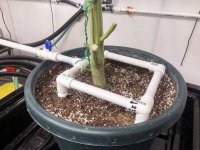This is a automated system for dosing, distributing, and disposing of nutrient for a small coco-based system.

It makes and distributes 12 gallons of nutrient twice a day, starting with a solenoid valve controlled by a timer which fills the tank to the proper level. The water first passes through a basic whole-house water filter which is positioned upstream of the solenoid valve.

After the tank is filled with fresh water, another timer controlling a circulating pump at the bottom of the tank and two air stones power on.
Then a Jecod Aquarium doser adds the proper amounts of nutrients to the tank in sequence using the doser's program, pulling the nutrient from these clear graduated storage tanks.


Yet another timer powers on a large sump pump in the nutrient tank that delivers the goods to 4 soaker rings through a 1/2" rigid pvc line that goes up the wall and across the center of the ceiling, where it splits and heads to opposite walls and down to a flexible hose leading to the feed rings. The plants sit in 3 x 3 trays which are elevated about 12" from the floor to allow drainage into a lowboy storage bin ( about 8" tall).

Now the final step - about 1/2 hour after each feeding ( to allow for drain-down), a small sump pump in each lowboy powers on, disposing of the waste nutes through a separate pvc line that runs along the perimeter of the room and snakes into a utility sink for disposal. These pumps power on for 2 minutes for the first drain-down, and again and hour later for one minute just in case there has been more drain-down. Float switches could also be used to accomplish this emptying.

It makes and distributes 12 gallons of nutrient twice a day, starting with a solenoid valve controlled by a timer which fills the tank to the proper level. The water first passes through a basic whole-house water filter which is positioned upstream of the solenoid valve.
After the tank is filled with fresh water, another timer controlling a circulating pump at the bottom of the tank and two air stones power on.
Then a Jecod Aquarium doser adds the proper amounts of nutrients to the tank in sequence using the doser's program, pulling the nutrient from these clear graduated storage tanks.
Yet another timer powers on a large sump pump in the nutrient tank that delivers the goods to 4 soaker rings through a 1/2" rigid pvc line that goes up the wall and across the center of the ceiling, where it splits and heads to opposite walls and down to a flexible hose leading to the feed rings. The plants sit in 3 x 3 trays which are elevated about 12" from the floor to allow drainage into a lowboy storage bin ( about 8" tall).
Now the final step - about 1/2 hour after each feeding ( to allow for drain-down), a small sump pump in each lowboy powers on, disposing of the waste nutes through a separate pvc line that runs along the perimeter of the room and snakes into a utility sink for disposal. These pumps power on for 2 minutes for the first drain-down, and again and hour later for one minute just in case there has been more drain-down. Float switches could also be used to accomplish this emptying.



 What a luxury! Good on you
What a luxury! Good on you Im gonna stay around here copying ideas. Im automating my room with arduino, I go slow, but I go.
Im gonna stay around here copying ideas. Im automating my room with arduino, I go slow, but I go.


